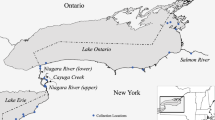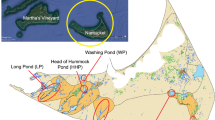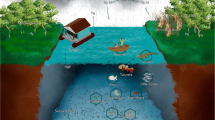Abstract
The South Carolina Department of Health and Environmental Control has collected, processed, and analyzed fish tissue total mercury (Hg) since 1976. For this study, skin-on-filet data from 1993 to 2007 were examined to determine biotic, spatial and temporal trends in tissue Hg levels for SC fishes. Because of the relatively high number of tissue Hg values below the analytical detection limits interval censored regression and censored least absolute deviations were used to construct several models to characterize trends. Large pelagic, piscivorous fish species, such as bowfin (Amia calva Linnaeus 1766), had higher levels of tissue Hg than smaller omnivorous species. Estuarine species had relatively low levels of tissue Hg compared to freshwater species, while two large open ocean species, king mackerel (Scomberomorus cavalla Cuvier 1829) and swordfish (Xiphias gladius Linnaeus 1758), had higher tissue Hg readings. For a given fish species, length was an important predictor of tissue Hg with larger individuals having higher levels than smaller individuals. The USEPA Level III ecoregion and water body type from where the fishes were collected were important in predicting the levels of tissue Hg. The Middle Atlantic Coastal Plain ecoregion had fishes with the highest levels of tissue Hg, while the Piedmont and Southern Coastal Plain ecoregions had the lowest. For a given ecoregion, large reservoirs and regulated rivers had fish with lower levels of tissue Hg than unregulated rivers. For reservoirs, the size of the impoundment was a significant predictor of tissue mercury with small reservoirs having higher levels of tissue mercury than large reservoirs. Landuse and water chemistry accounted for differences seen in fish of various ecoregions and waterbody types. Sampling locations associated with a high percentage of wetland area had fish with high levels of tissue Hg. Correlation analysis showed a strong positive relationship between tissue Hg levels and water column iron, total organic carbon, ammonia, and total kjedahl nitrogen, and a negative relationship with alkalinity, dissolved oxygen and pH. Results from principle component analysis revealed patterns between waterbody type and water chemistry variables that suggests hydrologic modification can have profound effects on the levels of fish tissue Hg in riverine systems. From 1993 to 2007, fish tissue Hg levels have trended lower. A spike in tissue Hg levels was observed in 2003–2005. The drying and rewetting of the landscape after the 2002 drought is hypothesized to have caused an increase in the methylation efficiencies of the system.








Similar content being viewed by others
References
Adams DH, McMichael RH Jr (2007) Mercury in king mackerel, Scomberomorus cavalla, and Spanish mackerel, S. maculates, from waters of the south-eastern USA: regional and historic trends. Mar Freshw Res 58:187–193
Bailey RG (1976) Ecoregions of the United States. Map (scale 1:7,500,000) USDA Forest Service, Intermountain Region, Ogden, UT
Barbour MT, Gerritsen J, Snyder BD, Stribling JB (1999) Rapid bioassessment protocols for use in wadeable streams and rivers: periphyton, benthic macroinvertebrates, and fish, 2nd edn. United States Environmental Protection Agency 841-B-99-002
Brumbaugh WG, Krabbenhoft DP, Helesel DR, Wiener JG, Echols JG (2001) A national pilot study of mercury contamination of aquatic ecosystems among multiple gradients: bioaccumulation in fish. USGS Biol Sci Rep 2001-0009, 25 pp
Cai Y, Rooker J, Gill G, Turner J (2007) Bioaccumulation of mercury in pelagic fishes from the northern Gulf of Mexico. Can J Fish Aquat Sci 64:458–469
Carroll BB, Hall GE (1964) Growth of catfishes in Norris Reservoir, Tennessee. J Tenn Acad Sci 39:86–91
Chen C, Amirbahman A, Fishe N, Harding G, Lamborg C, Nacci D, Taylor D (2008) Methylmercury in marine ecosystems: spatial patterns and processes of production, bioaccumulation, and biomagnification. Ecohealth 5:399–408
Cheshire A, Irish M (1987) Residual analysis in the grouped data and censored normal linear model. J Econom 34:33–62
Driscoll CT, Yan C, Schofield CL, Munson R, Holsapple J (1994) The mercury cycle and fish in the Adirondack lakes. Environ Sci Technol 28:136A–143A
ESRI (2008) ArcView Version 9.0. Earth Science Research Institute, Redlands
Gilmour CC, Henry EA (1991) Mercury methylation in aquatic systems affected by acid deposition. Environ Pollut 71:131–169
Gilmour CC, Krabbenhoft P, Orem W, Aiken G (2004) Influence of drying and rewetting on mercury and sulfur cycling in everglades and STA soils. Appendix 2B-1, South Florida Water Management District, West Palm Beach, FL
Gilmour CC, Riedel GS (2000) A survey of size-specific mercury concentrations in game fish from Maryland fresh and estuarine waters. Arch Environ Contam Toxicol 39:53–59
Greene WH (2003) Economic analysis. Upper Saddle River, NJ
Griffith GE, Omernik JM, Comstock JA., Schafale MP, McNab WH, Lenat DR, MacPherson TF, Glover JB, Shelburne VB (2002) Ecoregions of North Carolina and South Carolina (color poster and map, descriptive text, summary tables, and photographs). Reston, Virginia U.S. Geological Survey (map scale 1:1500000)
Guentzel JL (2009) Wetland influences on mercury transport and bioaccumulation in South Carolina. Sci Total Environ 407:1344–1353
Hall BD, Aiken GR, Krabbenhoft DP, Marvin-DiPasquale M, Swarzenski CM (2008) Wetlands as principal zones of methylmercury production in southern Louisiana and the Gulf of Mexico region. Environ Pollut 154:124–134
Hammerschmidt CR, Fitzgerald WF, Lamborg CH, Balcom PH, Visscher PT (2004) Biogeochemistry of methylmercury in sediments of Long Island Sound. Mar Chem 90:31–52
Hammerschmidt CR, Fitzgerald WF (2006) Methylmercury in freshwater fish linked to atmospheric mercury deposition. Environ Sci Technol 40:7764–7770
Hammond DL (1998) SC recreational dolphin fishery. South Carolina Department of Natural Reseources Special Report
Harrell FE Jr (2001) Regression modeling strategies: with applications to linear models, logistic regression, and survival analysis. Springer, New York
Helsel DR (2005) Nondetects and data analysis: statistics for censored environmental data. Wiley, Hoboken
Heyes A, Mason R, Kim E, Sunderland E (2006) Mercury methylation in estuaries: insights from using measuring rates using stable mercury isoptopes. Mar Chem 102:134–147
Jenkins RE, Burkhead NM (1993) Freshwater fishes of Virginia. American fisheries Society, Bethesda
Kamman NC, Lorey PM, Driscoll CT, Estabrook R, Major A, Pientka B, Glassford E (2003) Assessment of mercury in waters, sediments, and biota of New Hampshire and Vermont lakes, USA, sampled using a geographically randomized design. Environ Toxicol Chem 23:1172–1186
Kamman NC, Chalmers A, Clair TA, Major A, Moore SA, Shanley JB (2005a) Factors influencing mercury in freshwater surface sediments of Northeastern North America. Ecotoxicology 14:101–111
Kamman NC, Burgess NM, Driscoll CT, Simonin HA, Goodale W, Linehan J, Estbrook R, Hutcheson M, Major A, Scheuhammer AM, Scruton DA (2005b) Mercury in freshwater fish of northeast North America—a geographic perspective based on fish tissue monitoring databases. Ecotoxicology 14:163–180
Kraepiel AM, Keller K, Chin HB, Malcolm EG, Morel FMM (2003) Sources and variations of mercury in tuna. Environ Sci Technol 37:5551–5558
Lindberg S, Bullock R, Ebinghaus R, Engstrom D, Feng X, Fitzgerald W, Pirrone N, Prestbo E, Seigneur C (2007) A synthesis of progress and uncertainties in attributing the sources of mercury in deposition. Ambio 36:19–32
Louis VL, Rudd JMW, Kelly CA, Bodaly RA, Paterson MJ, Beaty KG, Hesslein RH, Heyes A, Majewski AH (2005) The rise and fall of mercury methylation in an experimental reservoir. Environ Sci Technol 38:1348–1358
Mason RP, Lawson NM, Lawrence AL, Leaner JJ, Lee JG, Sheu G (1999) Mercury in the Chesapeake Bay. Mar Chem 65:77–96
Mergler D, Anderson H, Chan L, Mahaffey K, Murray M, Sakamoto M, Stern A (2007) Methylmercury exposure and health effects in humans: a worldwide concern. Ambio 36:3–11
Munthe J, Bodaly R, Branfireum B, Driscoll C, Gilmour C, Harris R, Horvat M, Lucotte M, Malm O (2007) Recovery of mercury-contaminated fisheries. Ambio 36:33–44
Omernick JM (1987) Ecoregions of the conterminous United States. Ann Assoc Am Geogr 77:118–125
Omernick JM (2003) The misuse of hydrologic unit maps fpr extrapolation, reporting, and ecosystem management. J Am Water Resour Assoc 39:563–573
Paller MH, Jagoe CH, Bennett H, Brant HA, Bowers JA (2004) Influence of methyl mercury from tributary streams on mercury levels in Savannah river Asiatic clams. Sci Total Environ 325:209–219
Paller MH, Littrell JW (2007) Long-term changes in mercury in fish from the middle Savannah River. Sci Total Environ 382(2–3):375–382
Peles JD, Glenn TC, Brant HA, Wall AK, Jagoe CH (2006) Mercury concentrations in larmouth bass (Micropterus salmoides) from five South Carolina reservoirs. Water Air Soil Pollut 173:151–162
Poff NL, Allan JD, Bain MB, Karr JR, Prestegaard KL, Richter BD, Sparks RE, Stromberg JC (1997) The natural flow regime. Bioscience 47:769–784
Powell J (1984) Least absolute deviation estimation for the censored regression model. J Econom 25:303–325
Resh VH, Kobzina NG (2003) A perspective on the key citations in freshwater benthic science, and the studies that influenced them. J N Amer Benth Soc 22:341–351
Richter BD, Mathews R, Harrison DL, Wigington R (2003) Ecologically sustainable water management: managing river flows for ecological integrity. Ecol Appl 13:206–224
Rumbold DG, Fink LE (2006) Extreme spatial variability and unprecedented methylmercury concentrations within a constructed wetland. Environ Monit Assess 112:115–135
Rypel AL, Arrington DA, Findlay RH (2008) Mercury in Southeastern U.S. riverine fish populations linked to water body type. Environ Sci Technol 42:5118–5124
SAS Institute (2002) SAS/STAT Versions 8.2a. SAS Institute, Cary
SCDHEC (2001) Environmental investigations standard operating procedures and quality assurance manual. The South Carolina Department of Health and Environmental Control. 2600 Bull Street, Columbia SC 29201
SCDHEC (2008) State of South Carolina monitoring strategy. Technical Report No. 001-08. Bureau of Water. 2600 Bull St. Columbia SC 29201
SCDHEC (2009) South Carolina fish consumption advisories. Internet URL: http://www.scdhec.gov/fish. Accessed 01 Feb 2009
SCDNR (2009) Marine Resources Research Institute MRRI. Internet URL: http://www.dnr.sc.gov/marine/mrri/fish.html. Accessed 01 Feb 2009
Shanley JB, Kamman NC, Clair TA, Chalmers A (2005) Physical controls on total and methylmercury concentrations in streams and lakes of the Northeastern USA. Ecotoxicology 14:125–134
StataCorp LP (2009) Stata 10. Statacorp, College Station, TX USA
Tobin J (1958) Estimation of relationships for limited dependent variables. Econometrica 26:24–26
United States Geological Survey (2009) National water information system web interface. Internet URL: http://water.usgs.gov/. Accessed 01 Feb 2009
United States Environmental Protection Agency (1991) Methods for the determination of metals in environmental samples. EPA 60/04-91-010
United States Environmental Protection Agency (2007) Guidelines establishing test procedures for analysis of pollutants under the clean water act; national primary drinking water regulations; and national secondary drinking water regulations; analysis and sampling procedures; final rule. Federal Register 72:11201–11249
United States Environmental Protection Agency (2009a) The National listing of fish advisories NLFA. Internet URL: http://map1.epa.gov/. Accessed 01 Feb 2009
United States Environmental Protection Agency (2009b) 2006 National landcover data (NLCD 2006). Internet URL: http://www.epa.gov/mrlc/nlcd-2006.html. Accessed 01 Feb 2009
United States Enviroenmental Protection Agency (2009c) STORET database access. Internet URL: http://www.epa.gov/storet/. Accessed 01 Feb 2009
United States Environmental Protection Agency (2009d) Guidance for implementing the January 2001 methylmercury water quality criterion. EPA 833-R-09-002
Acknowledgments
We thank the many dedicated professionals, both past and present, at the South Carolina Department of Health and Environmental Control who made this project possible. Sandra Flemming, SCDHEC, kindly reviewed portions of the manuscript and made valuable comments, for which we are grateful. We also acknowledge staff with the South Carolina Department of Natural Resources who generously provided fish tissue from saltwater species. We acknowledge the important contributions of the anonymous referees of this manuscript, whose careful reviews added to the quality of the end product. We thank Commissioner C. Earl Hunter, SCDHEC, for his commitment to the promotion of health and the protection of the environment in South Carolina.
Author information
Authors and Affiliations
Corresponding author
Rights and permissions
About this article
Cite this article
Glover, J.B., Domino, M.E., Altman, K.C. et al. Mercury in South Carolina Fishes, USA. Ecotoxicology 19, 781–795 (2010). https://doi.org/10.1007/s10646-009-0455-6
Accepted:
Published:
Issue Date:
DOI: https://doi.org/10.1007/s10646-009-0455-6




